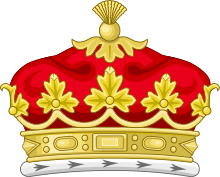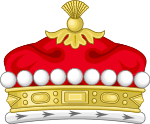Viscount
A viscount (/ˈvaɪkaʊnt/ (![]()
In many countries a viscount, and its historical equivalents, was a non-hereditary, administrative or judicial position, and did not develop into an hereditary title until much later.[3] In the case of French viscounts, it is customary to leave the title untranslated as vicomte [vi.kɔ̃t].
Etymology
The word viscount comes from Old French visconte (Modern French: vicomte), itself from Medieval Latin vicecomitem, accusative of vicecomes, from Late Latin vice- "deputy" + Latin comes (originally "companion"; later Roman imperial courtier or trusted appointee, ultimately count).[4]
History
During the Carolingian Empire, the kings appointed counts to administer provinces and other smaller regions, as governors and military commanders. Viscounts were appointed to assist the counts in their running of the province, and often took on judicial responsibility.[3] The kings strictly prevented the offices of their counts and viscounts from becoming hereditary, in order to consolidate their position and limit chance of rebellion.[3]
The title was in use in Normandy by at least the early 11th century.[5] Similar to the Carolingian use of the title, the Norman viscounts were local administrators, working on behalf of the Duke.[6] Their role was to administer justice and to collect taxes and revenues, often being castellan of the local castle. Under the Normans, the position developed into a hereditary one, an example of such being the viscounts in Bessin.[6] The viscount was eventually replaced by bailiffs, and provosts.[6]
As a rank in British peerage, it was first recorded in 1440, when John Beaumont was created Viscount Beaumont by King Henry VI.[7] The word viscount corresponds in the UK to the Anglo-Saxon shire reeve (root of the non-nobiliary, royal-appointed office of sheriff). Thus early viscounts were originally normally given their titles by the monarch, not hereditarily; but soon they too tended to establish hereditary principalities in the wider sense. They were a relatively late introduction to the British peerage, and on the evening of the Coronation of Queen Victoria in 1838, the Prime Minister Lord Melbourne explained to her why (from her journals):
I spoke to Ld M. about the numbers of Peers present at the Coronation, & he said it was quite unprecedented. I observed that there were very few Viscounts, to which he replied "There are very few Viscounts," that they were an old sort of title & not really English; that they came from Vice-Comites; that Dukes & Barons were the only real English titles;—that Marquises were likewise not English, & that people were mere made Marquises, when it was not wished that they should be made Dukes.[8]
Early modern and contemporary usage
Belgium
In Belgium a few families are recognised as Viscounts:
- Viscount of Audenaerde
- Viscount of Hombeke
- Viscount de Spoelberch
- Viscount Eyskens
- Viscount Frimout
- Viscount Poullet
United Kingdom
 |
| Part of a series on |
| Peerage |
|---|
|
Types |
|
Divisions |
|
History |
| House of Lords |
|
A viscount is the fourth rank in the British peerage system, standing directly below an earl and above a baron (Lord of Parliament in Scotland). There are approximately 270 viscountcies currently extant in the peerages of the British Isles, though most are secondary titles.[9]
In British practice, the title of a viscount may be either a place name, a surname, or a combination thereof: examples include the Viscount Falmouth, the Viscount Hardinge and the Viscount Colville of Culross, respectively. An exception exists for Viscounts in the peerage of Scotland, who were traditionally styled "The Viscount of [X]", such as the Viscount of Arbuthnott. In practice, however, very few maintain this style, instead using the more common version "The Viscount [X]" in general parlance, for example Viscount of Falkland who is referred to as Viscount Falkland.
A British viscount is addressed in speech as Lord [X], while his wife is Lady [X], and he is formally styled "The Right Honourable The Viscount [X]". The children of a viscount are known as The Honourable [Forename] [Surname], with the exception of the eldest child of a Scottish viscount, whose eldest child may be styled as "The Honourable Master of [X]".[10]
Ireland
The title of viscount (Irish: bíocunta) was introduced to the Peerage of Ireland in 1478 with the creation of the title of Viscount Gormanston, the senior viscountcy of Britain and Ireland, held today by Jenico Preston, 17th Viscount Gormanston. Other early Irish viscountcies were Viscount Baltinglass (1541), Viscount Clontarf (1541), Viscount Mountgarret (1550) and Viscount Decies (1569).
Use as a courtesy title
A specifically British custom is the use of viscount as a courtesy title for the heir of an earl or marquess. The peer's heir apparent will sometimes be referred to as a viscount, if the second most senior title held by the head of the family is a viscountcy. For example, the eldest son of the Earl Howe is Viscount Curzon, because this is the second most senior title held by the Earl.[11]
However, the son of a marquess or an earl can be referred to as a viscount when the title of viscount is not the second most senior if those above it share their name with the substantive title. For example, the second most senior title of the Marquess of Salisbury is the Earl of Salisbury, so his heir uses the lower title of Viscount Cranborne.
Sometimes the son of a peer can be referred to as a viscount even when he could use a more senior courtesy title which differs in name from the substantive title. Family tradition plays a role in this. For example, the eldest son of the Marquess of Londonderry is Viscount Castlereagh, even though the Marquess is also the Earl Vane.
On occasion, the title of viscount may be the courtesy title used for the grandson of a duke, provided that he is the eldest son of the duke's eldest son. This is because the eldest son of the duke will be given the second highest title of his father (marquess or earl), and so the third-highest is left for his eldest son. It is possible for the great-grandson of a duke to hold the courtesy title of viscount if the duke's eldest son has the courtesy title marquess and his eldest son, in turn, uses the title of earl.
Coronet


A viscount's coronet of rank bears 16 silver balls around the rim. Like all heraldic coronets, it is mostly worn at the coronation of a sovereign, but a viscount has the right to bear his coronet of rank on his coat of arms, above the shield. In this guise, the coronet is shown face-on, featuring 9 silver balls.[12]
Jersey
The island of Jersey still retains an officer whose function is purely to administer orders of the island's judiciary, and whose position remains non-hereditary. The role of the Viscount of Jersey (French: Vicomte de Jersey) involves managing fines, bail monies, seizures, confiscations, evictions, service of process, arrests for non-appearance in court and other enforcement procedures, as well acting as coroner for sudden or unexpected deaths and managing jury selection.[13]
Portugal
In the former kingdom of Portugal a visconde ranks above a barão (baron) and below a conde (count). The first Portuguese viscountcy, that of D. Leonel de Lima, visconde de Vila Nova de Cerveira, dates from the reign of Afonso V. A flood of viscountcies, some 86 new titles, were awarded in Portugal between 1848 and 1880.
Spain
The Spanish title of vizconde is ranked between the title conde (count/earl) and the relatively rare title of barón.
In Spain, nobles are classified as either Grandee of Spain (Grandes de España), as titled nobles, or as untitled nobles. A grandee of any rank outranks a non-grandee, even if that non-grandee's title is of a higher degree, thus, a viscount-grandee enjoys higher precedence than a marquis who is not a grandee.
In the kingdom of Spain the title was awarded from the reign of Felipe IV (1621–65; Habsburg dynasty) until 1846.
Equivalent titles
Germanic counterparts
There are non-etymological equivalents to the title of viscount (i.e., 'vice-count') in several languages, including German.
However, in such case titles of the etymological Burgrave family (not in countries with a viscount-form, such as Italian burgravio alongside visconte) bearers of the title could establish themselves at the same gap, thus at generally the same level. Consequently, a Freiherr (or Baron) ranks not immediately below a Graf, but below a Burggraf.
Thus in Dutch, Burggraaf is the rank above Baron, below Graaf (i.e., Count) in the kingdoms of the Netherlands and of Belgium (by Belgian law, its equivalents in the other official languages are Burggraf in German and vicomte in French). In Welsh the title is rendered as Isiarll.
Non-Western counterparts
Like other major Western noble titles, viscount is sometimes used to render certain titles in non-western languages with their own traditions. Even though they are considered 'equivalent' in relative rank, they are as a rule historically unrelated and thus hard to compare.
The Japanese cognate shishaku (shi) (Japanese: 子爵) was the fourth of the five peerage ranks established in the Meiji era. The Japanese system of nobility, Kazoku, which existed between 1884 and 1947 was based heavily on the British peerage. At the creation of the system, viscounts were the most numerous of all the ranks, with 324 being created compared to 11 non-imperial princes or dukes, 24 marquesses, 76 counts and 74 barons, for a total of 509 peers.[14]
Other equivalent titles existed, such as:
- the Chinese tzu-chueh (tzu) or zijue (zi) (Chinese: 子爵), hereditary title of nobility first established in the Zhou dynasty
- the Korean cognate jajak or Pansŏ
- the Vietnamese cognate Tử
- the Manchu jingkini hafan
In fiction
Viscounts and viscountesses have occasionally appeared in works of fiction. For examples of fictional viscounts and viscountesses, see List of fictional nobility#Viscounts and viscountesses.
See also
- List of British Viscountcies
- List of Viscountcies in Portugal
- Several Italian noble dynasties
- Visconti of Milan, ruled Milan from 1277 to 1447
- Visconti di Modrone, collateral branch of the Visconti of Milan
- Visconti of Pisa and Sardinia, ruled Gallura in Sardinia from 1207 to 1250
- Visconti of Milan, ruled Milan from 1277 to 1447
References
- Viscount. Collins Dictionary. n.d. Retrieved 22 September 2014.
- Viscountess. Collins Dictionary. n.d. Retrieved 22 September 2014.
- Upshur, Jiu-Hwa; Terry, Janice; Holoka, Jim; Goff, Richard; Cassar, George H. (2011). Cengage Advantage Books: World History. I. California: Wadsworth Publishing Co Inc. p. 329. ISBN 9781111345167.
- "Viscount (n.)". Online Etymology Dictionary. Retrieved 18 June 2014.
- Loud, G. A. (1999). Conquerors and churchmen in Norman Italy. Surrey, UK: Ashgate Publishing Co. p. 4. ISBN 9780860788034.
- Petit-Dutaillis, C. (1936). The Feudal Monarchy in France and England. Oxford, UK: Routledge. p. 162. ISBN 9781136203503.
- "Journals of the House of Lords". cii. 1870: 512. Retrieved 16 June 2014. Cite journal requires
|journal=(help) - "28 June 1838". Queen Victoria's Journals. 4. Buckingham Palace, Princess Beatrice's copies. 1 June – 1 October 1838. p. 84. Retrieved 25 May 2013.
- Denyer, Ian; Bavister, Grant (2014) [2004]. "The Roll of the Peerage" (PDF). College of Arms. Retrieved 18 June 2014.
- "Viscount and Viscountess". Debretts. n.d. Retrieved 18 June 2014.
- "Courtesy Titles". Debretts. n.d. Retrieved 18 June 2014.
- "Ceremonial Robes". Debretts. n.d. Retrieved 18 June 2014.
- "Functions of the Viscount's Department". States of Jersey. n.d. Retrieved 17 June 2014.
- Jansen, The Making of Modern Japan, p. 391.
.svg.png)